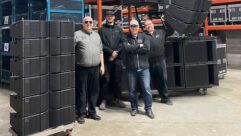ENTERTAINMENT OR NOISE?
Nov 1, 2002 12:00 PM,
GLEN BALLOU
You have all heard the termsCD, DVD, stereo, home theater, subwoofer, plasma display, andCRT. After all, most of you have some form of entertainment system or systems in your homes. But what about the weekend retreat place, namely yachts? If there is one place where you should be able to sit back, relax, and enjoy listening to good music or appreciate a good movie, it would be your getaway place.
What is the difference between home systems and yacht systems? Most likely the environment, the size and height of the rooms, the acoustic characteristics of the rooms, the background noise, the power available, and the ability to conceal the wiring, the electronics, and the loudspeakers.
Large yachts often operate on 120 or 220 VAC and run the air conditioning system continuously. This type of yacht can use “home” type electronics. However, to make it attractive and unobtrusive requires custom installations and often custom-designed loudspeaker enclosures, which may be separate, freestanding enclosures or ones built in to the yacht.
The rooms are often designed to look beautiful, but the sound gets lost in the process. Think of restaurants where the food is great but something is wrong. The chances are that they are acoustically unpleasant — they’re too noisy, they’re too reverberant, or they don’t have a good balance of high and low frequencies. Proper acoustic materials placed in appropriate locations can turn a poor acoustic environment into a pleasing one without affecting the visual appearance of the room. Yachts, because of their size and shape, often offer acoustical challenges beyond those in the home. Yachts are not stationary, so 20-foot swells can raise havoc with anything that is not properly secured, which can pose a danger to the ship and personnel.
ANCHORS AWAY
Each bedroom suite should have an individual system for that special getaway time. How many people listen to music or watch TV in bed? All large yachts should also have an emergency paging system. Home-style equipment will not work here. Special high-temperature wire or wire installed in conduit is required, and the loudspeakers must meet the same fire specifications as in hotels and other public areas.
Outdoor areas require waterproof loudspeakers. Freshwater yachts may get away with home patio loudspeakers, but vessels operating in saltwater need true waterproof and environment-proof loudspeakers.
The bridge is an area where it is good to have sound. However, this area is often too noisy for the average loudspeakers installed in the console aiming at the knees. Remember: aiming a loudspeaker at the listener’s head increases articulation, or the ability to hear and understand. The VHF radio is also hard to hear on the bridge. That condition can be improved by feeding the VHF signal into the bridge sound system through a muting device that turns off or reduces the entertainment channel when the VHF message is on. The cockpit of a sailboat can also be noisy when running under engine to get to a weekend retreat.
For the smaller yacht operating on 12 or 24 VDC, different parameters exist. Car radios are often advertised for $159 with 40W or more power. The truth is that unless the radio has a built-in inverter to raise the DC voltage from 12 to 40 VDC or more, the RMS power (Wrms) output into a 3.2Ω or typical car loudspeaker can’t be more than about 8W at 14.7V. If the voltage is internally increased to 40 VDC, the power increases to 60W, but not at $159.
To eliminate that problem, separate high-power amplifiers can be employed. The average sound-pressure level (SPL) on the bridge with the engines running at 2,000 to 3,000 rpm ranges from 82 to 90 dB SPL. A typical car loudspeaker has a sensitivity of 82 to 85 dB SPL at 1 meter (3 feet, 4 inches) for 1W of input power. That means that 1W of amplifier power will deliver 82 dB of sound, or the same level as the noise. Whereas the listener’s brain is good at separating the chaff from the wheat, it cannot separate equal level noise from voice. To correct that, you need to drive the loudspeaker with more power.
Now comes the problem. The 8W output is for a steady-state sine wave. Voice and music have sharp peaks and valleys that correlate to a crest factor of 10 to 20 dB. That means the actual continuous power you can get out of the amplifier without gross distortion is only about 1W. You get around that problem by using more power and more efficient loudspeakers. This condition can also exist throughout the yacht and must be handled in the same way.
Don’t forget the cockpit or fantail, after all, because you probably spend more time there than below deck. As in the megayacht, loudspeakers should be waterproof and environment proof, and all wiring should be tinned to eliminate corrosion. Again, the loudspeakers should be aimed at the ears, not at the feet or knees.
It is sometimes hard to disguise the sound system in smaller yachts, but with a little ingenuity, it can be accomplished. Matching wood veneers for loudspeaker enclosures, building the loudspeakers into the walls or ceiling, enclosing the electronics behind doors, and concealing the wire go a long way toward making the environment pleasing and relaxing. Remember that hiding the system is not always easy, and it must be readily accessible. The loudspeakers and video screen must be in a location where they can be seen and heard by everyone.
Is installing the proper home theater or sound system a do-it-yourself project? Under most conditions, no. A properly designed and installed system will make the environment pleasing to the eyes and to the ears and will be useful for many years.
Glen Ballou owns Innovative Communications and is the author of The Handbook for Sound Engineers — The New Audio Cyclopedia.










